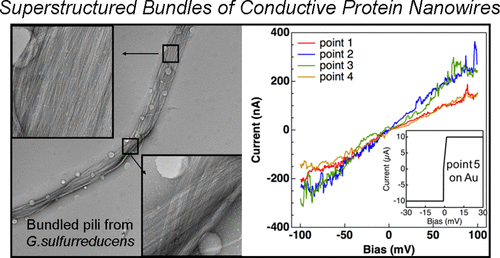当前位置:
X-MOL 学术
›
Biomacromolecules
›
论文详情
Our official English website, www.x-mol.net, welcomes your
feedback! (Note: you will need to create a separate account there.)
Solvent-Induced Assembly of Microbial Protein Nanowires into Superstructured Bundles
Biomacromolecules ( IF 5.5 ) Pub Date : 2021-02-16 , DOI: 10.1021/acs.biomac.0c01790 Yun-Lu Sun 1 , Brian J Montz 2 , Ryan Selhorst 2 , Hai-Yan Tang 1 , Jiaxin Zhu 3 , Kelly P Nevin 1 , Trevor L Woodard 1 , Alexander E Ribbe 2 , Thomas P Russell 2 , Stephen S Nonnenmann 3 , Derek R Lovley 1 , Todd Emrick 2
Biomacromolecules ( IF 5.5 ) Pub Date : 2021-02-16 , DOI: 10.1021/acs.biomac.0c01790 Yun-Lu Sun 1 , Brian J Montz 2 , Ryan Selhorst 2 , Hai-Yan Tang 1 , Jiaxin Zhu 3 , Kelly P Nevin 1 , Trevor L Woodard 1 , Alexander E Ribbe 2 , Thomas P Russell 2 , Stephen S Nonnenmann 3 , Derek R Lovley 1 , Todd Emrick 2
Affiliation

|
Protein-based electronic biomaterials represent an attractive alternative to traditional metallic and semiconductor materials due to their environmentally benign production and purification. However, major challenges hindering further development of these materials include (1) limitations associated with processing proteins in organic solvents and (2) difficulties in forming higher-order structures or scaffolds with multilength scale control. This paper addresses both challenges, resulting in the formation of one-dimensional bundles composed of electrically conductive protein nanowires harvested from the microbes Geobacter sulfurreducens and Escherichia coli. Processing these bionanowires from common organic solvents, such as hexane, cyclohexane, and DMF, enabled the production of multilength scale structures composed of distinctly visible pili. Transmission electron microscopy revealed striking images of bundled protein nanowires up to 10 μm in length and with widths ranging from 50–500 nm (representing assembly of tens to hundreds of nanowires). Conductive atomic force microscopy confirmed the presence of an appreciable nanowire conductivity in their bundled state. These results greatly expand the possibilities for fabricating a diverse array of protein nanowire-based electronic device architectures.
中文翻译:

溶剂诱导的微生物蛋白纳米线组装成超结构束
蛋白质基电子生物材料因其对环境无害的生产和纯化而成为传统金属和半导体材料的有吸引力的替代品。然而,阻碍这些材料进一步发展的主要挑战包括(1)与在有机溶剂中加工蛋白质有关的局限性,以及(2)难以形成具有多长度尺度控制的高级结构或支架的困难。本文解决了这两个挑战,导致形成了一维束,该束由导电的蛋白质纳米线组成,这些蛋白质是从还原性土壤杆菌和大肠杆菌中收获的。用普通的有机溶剂(例如己烷,环己烷和DMF)加工这些仿生纳米丝,可以生产由明显可见的菌毛组成的多尺度结构。透射电子显微镜显示了捆扎的蛋白质纳米线的惊人图像,长度达10μm,宽度范围为50-500 nm(代表数十个到数百个纳米线的组装)。导电原子力显微镜证实了在其捆扎状态下存在明显的纳米线导电性。这些结果极大地扩展了制造各种基于蛋白质纳米线的电子设备体系结构的可能性。
更新日期:2021-03-08
中文翻译:

溶剂诱导的微生物蛋白纳米线组装成超结构束
蛋白质基电子生物材料因其对环境无害的生产和纯化而成为传统金属和半导体材料的有吸引力的替代品。然而,阻碍这些材料进一步发展的主要挑战包括(1)与在有机溶剂中加工蛋白质有关的局限性,以及(2)难以形成具有多长度尺度控制的高级结构或支架的困难。本文解决了这两个挑战,导致形成了一维束,该束由导电的蛋白质纳米线组成,这些蛋白质是从还原性土壤杆菌和大肠杆菌中收获的。用普通的有机溶剂(例如己烷,环己烷和DMF)加工这些仿生纳米丝,可以生产由明显可见的菌毛组成的多尺度结构。透射电子显微镜显示了捆扎的蛋白质纳米线的惊人图像,长度达10μm,宽度范围为50-500 nm(代表数十个到数百个纳米线的组装)。导电原子力显微镜证实了在其捆扎状态下存在明显的纳米线导电性。这些结果极大地扩展了制造各种基于蛋白质纳米线的电子设备体系结构的可能性。











































 京公网安备 11010802027423号
京公网安备 11010802027423号